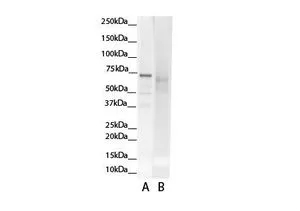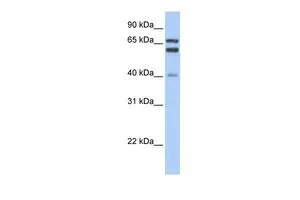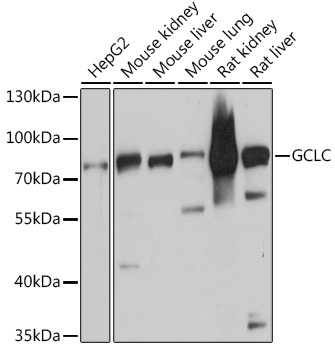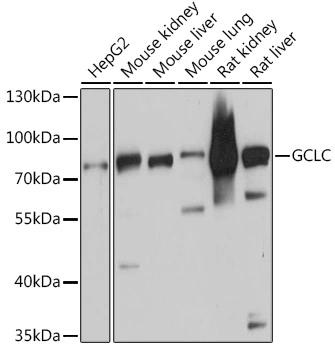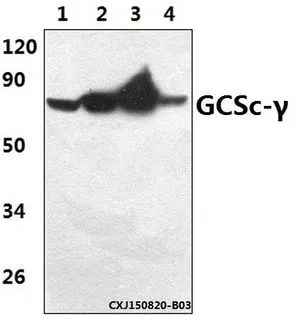
IHC-P analysis of human bronchial epithelial tissue using GTX16315 GCLC antibody at 1:600. Left to right : DAPI, GCLC, Merge. Low pH, heat-induced antigen retrieval method utilizing Sodium Citrate buffer.
GCLC antibody, N-term
GTX16315
ApplicationsWestern Blot, ImmunoHistoChemistry, ImmunoHistoChemistry Paraffin
Product group Antibodies
TargetGCLC
Overview
- SupplierGeneTex
- Product NameGCLC antibody, N-term
- Delivery Days Customer9
- Application Supplier NoteWB: 0.2-2.5 ug/ml. IHC-P: 2-10 ug/ml. *Optimal dilutions/concentrations should be determined by the researcher.Not tested in other applications.
- ApplicationsWestern Blot, ImmunoHistoChemistry, ImmunoHistoChemistry Paraffin
- CertificationResearch Use Only
- ClonalityPolyclonal
- Concentration0.5-1 mg/ml
- ConjugateUnconjugated
- Gene ID2729
- Target nameGCLC
- Target descriptionglutamate-cysteine ligase catalytic subunit
- Target synonymsCNSHA7, GCL, GCS, GLCL, GLCLC, glutamate--cysteine ligase catalytic subunit, GCS heavy chain, gamma-ECS, gamma-glutamylcysteine synthetase
- HostRabbit
- IsotypeIgG
- Protein IDP48506
- Protein NameGlutamate--cysteine ligase catalytic subunit
- Scientific DescriptionGlutamate-cysteine ligase, also known as gamma-glutamylcysteine synthetase is the first rate-limiting enzyme of glutathione synthesis. The enzyme consists of two subunits, a heavy catalytic subunit and a light regulatory subunit. This locus encodes the catalytic subunit, while the regulatory subunit is derived from a different gene located on chromosome 1p22-p21. Mutations at this locus have been associated with hemolytic anemia due to deficiency of gamma-glutamylcysteine synthetase and susceptibility to myocardial infarction.[provided by RefSeq, Oct 2010]
- Storage Instruction-20°C or -80°C,2°C to 8°C
- UNSPSC12352203
References
- Idei U, Ohta T, Yamatani H, et al. Mechanism of Cell Death by Combined Treatment with an xCT Inhibitor and Paclitaxel: An Alternative Therapeutic Strategy for Patients with Ovarian Clear Cell Carcinoma. Int J Mol Sci. 2023,24(14). doi: 10.3390/ijms241411781Read this paper
- Sendo K, Seino M, Ohta T, et al. Impact of the glutathione synthesis pathway on sulfasalazine-treated endometrial cancer. Oncotarget. 2022,13:224-236. doi: 10.18632/oncotarget.28185Read this paper
- Hseu YC, Vudhya Gowrisankar Y, Chen XZ, et al. The Antiaging Activity of Ergothioneine in UVA-Irradiated Human Dermal Fibroblasts via the Inhibition of the AP-1 Pathway and the Activation of Nrf2-Mediated Antioxidant Genes. Oxid Med Cell Longev. 2020,2020:2576823. doi: 10.1155/2020/2576823Read this paper
- Hseu YC, Chang CT, Gowrisankar YV, et al. Zerumbone Exhibits Antiphotoaging and Dermatoprotective Properties in Ultraviolet A-Irradiated Human Skin Fibroblast Cells via the Activation of Nrf2/ARE Defensive Pathway. Oxid Med Cell Longev. 2019,2019:4098674. doi: 10.1155/2019/4098674Read this paper
- Huang SY, Chang SF, Chau SF, et al. The Protective Effect of Hispidin against Hydrogen Peroxide-Induced Oxidative Stress in ARPE-19 Cells via Nrf2 Signaling Pathway. Biomolecules. 2019,9(8). doi: 10.3390/biom9080380Read this paper
- Wu CT, Deng JS, Huang WC, et al. Salvianolic Acid C against Acetaminophen-Induced Acute Liver Injury by Attenuating Inflammation, Oxidative Stress, and Apoptosis through Inhibition of the Keap1/Nrf2/HO-1 Signaling. Oxid Med Cell Longev. 2019,2019:9056845. doi: 10.1155/2019/9056845Read this paper
- Hseu YC, Ho YG, Mathew DC, et al. The in vitro and in vivo depigmenting activity of Coenzyme Q10 through the down-regulation of α-MSH signaling pathways and induction of Nrf2/ARE-mediated antioxidant genes in UVA-irradiated skin keratinocytes. Biochem Pharmacol. 2019,164:299-310. doi: 10.1016/j.bcp.2019.04.015Read this paper
- Hseu YC, Korivi M, Lin FY, et al. Trans-cinnamic acid attenuates UVA-induced photoaging through inhibition of AP-1 activation and induction of Nrf2-mediated antioxidant genes in human skin fibroblasts. J Dermatol Sci. 2018,90(2):123-134. doi: 10.1016/j.jdermsci.2018.01.004Read this paper
- Yang HL, Lee CL, Korivi M, et al. Zerumbone protects human skin keratinocytes against UVA-irradiated damages through Nrf2 induction. Biochem Pharmacol. 2018,148:130-146. doi: 10.1016/j.bcp.2017.12.014Read this paper
- Wu YL, Chang JC, Lin WY, et al. Caffeic acid and resveratrol ameliorate cellular damage in cell and Drosophila models of spinocerebellar ataxia type 3 through upregulation of Nrf2 pathway. Free Radic Biol Med. 2018,115:309-317. doi: 10.1016/j.freeradbiomed.2017.12.011Read this paper

